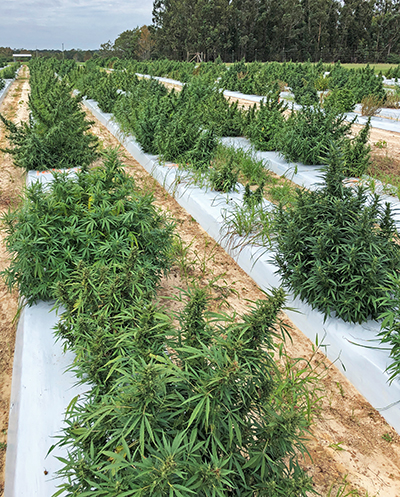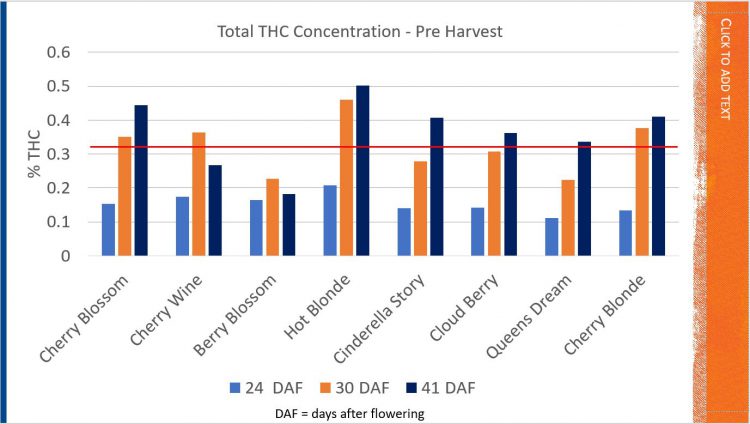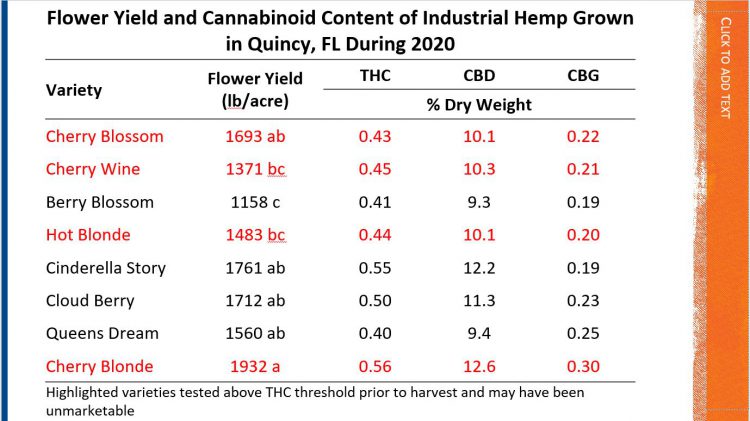Josh Freeman, Horticultural Specialist, UF/IFAS North Florida Research and Education Center
–

Figure 1. 2020 NFREC Hemp variety trial seedlings from feminized seed grown on raised plasticulture beds. Credit: Josh Freeman, UF/IFAS
After the first year of industrial hemp (IH) research in 2019, we had a pretty good idea of how some varieties would perform in our area. The yields in North Florida were similar to or better than other areas, based on feedback we had received from growers in other Southeastern states. Unfortunately, we just weren’t able to test many varieties in 2019, so it was hard to make broad generalizations about what to expect with the crop. Many things have changed since then. Much of the interest in IH has waned, largely due to significant drop in the value of end products, such as CBD oil, which may only be 20% of what it was three years ago. Data from research such as ours has also pointed to the risk of many hemp varieties going over the .03% THC threshold and becoming unmarketable. We were cautious to make sweeping statements with such small datasets, so we pressed on into the 2020 research season.
The number of hemp varieties investigated was increased from five in 2019 to eight in 2020 with the intention of getting better resolution on IH performance in our region. That said, we still only worked with a limited number of varieties. Hemp has a multitude of varieties that are available to growers, far too many for us to test in a single trial. Our production methods in 2020 were similar to 2019, where we used seedlings from feminized seed grown on raised plasticulture beds (Figure 1). Our planting date in 2020 was July 14, which is late in the planting season. Our experience suggests that planting in early to mid-June would probably be best, and would allow growers to use lower plant populations. One positive from 2020, seedling uniformity was much better than it was in 2019.
Just as in 2019, many of the hemp varieties that were tested in 2020 exceeded the 0.3% THC threshold. Only one of eight varieties remained below threshold throughout the season. In 2020, varieties exceeded threshold between 4-6 weeks after flowering initiated (Figure 2).

THC Concentration levels from 2020 Hemp Variety Trial at NFREC in Quincy, FL. Credit: Josh Freeman, UF?IFAS
–
Yields were still respectable in 2020, but were lower than 2019, likely due to the later planting date (Figure 3). Another similarity between years was the presence of caterpillar pests near the end of the season, especially feeding on the flowers.
–
There may still be opportunities for producers to profitably grow industrial hemp, but the risks still remain. The Primary risk is going above THC threshold and having an unmarketable crop. Hemp growers should begin THC sampling early, ideally the second week after flowering begins and sample twice per week. In 2020, we saw some of our largest weekly jumps ever, in some instances, with the THC content nearly tripling over one week.
Results from various research sites across the state can be found on the University of Florida’s Industrial Hemp Pilot Program website. We will soon be adding results from our 2020 research. If you have any questions regarding industrial hemp production, contact your local county extension agent, or one of the resources listed on Hemp Pilot Program website.
- NFREC Faculty Tribute to Arnie Forrester - February 11, 2022
- Tomato Varieties for 2022 - January 28, 2022
- Pumpkin Production in North Florida - July 30, 2021

